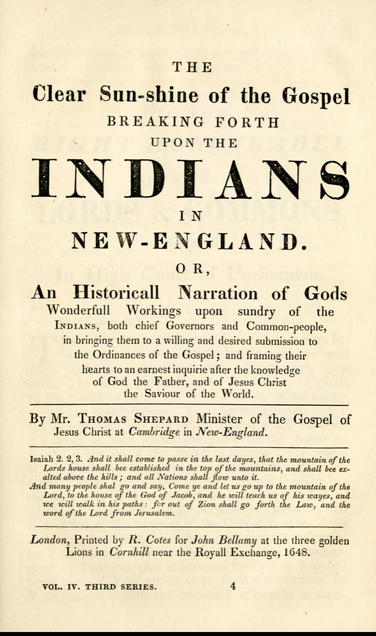Thomas Shepard, The Clear Sun-shine of the Gospel breaking forth upon the Indians in New-England (London, 1648)(pages 24-64)

Rishab Nair and Ryan Feriancek
The artifact at the center of our research paper is The Clear Sun-Shine of the Gospel Breaking forth upon the Indians in New England, and how it demonstrates the greater cultural and religious changes among the Puritans and the Wampanoag during the conversion effort in the fifteenth century. The work is a religious tract written in 1648 by Thomas Shepard, who was the minister of Cambridge at the time, and chronicles his visit to Cape Cod to observe the progress of conversion among the native peoples. The work is intended to be a report on the progress, as well as an appeal to Parliament seeking further support for the conversion effort. This essay investigates the religious perspectives and goals of both the Puritans and the Wampanoag, as well as the cultural impact interactions had on each group.
The artifact makes it immediately clear to readers that missionaries’ primary goal was conversion of the Indians into Christianity. Further, a constant and repetitive message that was used was that people should celebrate good beginnings and hope for an excellent future. The main intention was to simply go to distant lands and spread the word of the lord and savior Jesus Christ. Missionaries hoped to distance themselves from previous sins and propagate the ideas of Christianity to rid themselves from their past. The artifact brings about the notion that these Puritans decided to take destiny into their own hands and annexe land that Christ would plan to take. The Indians made the Puritans aware of previous encounters with Christianity. They were bearish due to “nightmares” about God’s anger and mercy. Soon enough, through the work of missionaries, the Indians realized that they must work hard to serve God and live a life of fulfilment.
In the next section, we dive into the cultural impact of puritans. The artifact glorifies the semi-Catholic approach used by missionaries lacking Bibles, which involved mass-style gatherings and often resulted in hybridization of native religion and Chrisitianity, much like how Catholic missionaries operated. The paper brings about how Eliot navigates through language barriers and helps out members of the community to build great rapport with the Indians and to push his message across. This section also contains information about Mr. Thomas Shepard Minister of the Gospel of Jesus Christ at Cambridge in New-England. As a consequence of the missionaries introducing Christianity and converting the Indians, they were put on a pedestal and adorned a perpetuated sense of superiority. This notion is driven further in the paper before we move onto Wampoanog’s religious and cultural beliefs.
For the rest of the essay we focus on the Wampanoag perspective. According to the information contained in Clear Sun-shine, great progress had indeed been made in the effort to convert the Wampanoag. In terms of numbers, many Indians had converted, as well as a number of sachems, resulting in Christianization of multiple full tribes. Puritan values and practices were being embraced on an individual basis, and the Wampanoag were starting to become better versed in the theology of Christianity. The work relates many religious questions the Wampanoag had, from how to deal with disobedient children to how to deal with finding themselves sinful. They were not exclusively attracted to Christianity by its values, as many Indians sought out Christianity for practical purposes, some even for fear of their local shamans. By this time Christianity was firmly established among the Wampanoag, and would remain so for years to come.
The next section details the cultural impacts of conversion on the Wampanoag. The adoption of Christianity by the Wampanoag was accompanied by many cultural changes. Encouraged by ministers, they began to integrate Christian practices into their daily life, much as the Puritans did. Daily prayer was widely adopted, and they began looking to God for help in all aspects of life. Many Wampanoag had also sanctified the sabbath, and had to weigh that against their traditional practices regarding work. Additionally, an Indian court was established, aiding in the formal enforcement of the new Puritan-influenced laws.
The Clear Sun-Shine of the Gospel Breaking forth upon the Indians in New England demonstrates the depth of the religious and cultural impact the conversion effort had on the Puritans as well as the Wampanoag. Its information is filtered through the perspective of a Puritan minister, which further highlights the prominence of religion in the Puritan mindset. Through the interactions and observations of Shepard and his contact we see that Christianity was finding its place in Wampanoag society. The work is a valuable source of insight into this age in Boston’s history.
Click here to return to the main final project page